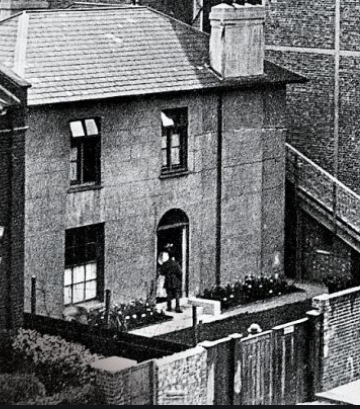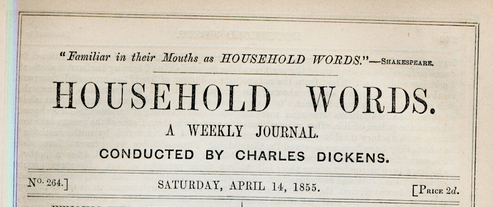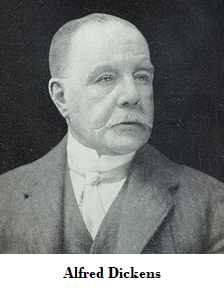
On June 9, 1870, Charles Dickens died at his beloved Gad’s Hill Place in Kent (above). He was fifty-eight.
He had first seen the house when he was nine years old when his father told him that if he worked hard enough, one day he would own it or one like it. As a boy, he would often walk from Chatham to Gad’s Hill Place, as he wanted to see it again and again as an image of his future. He later wrote, “I used to look at it as a wonderful Mansion (which God knows it is not) when I was a very odd little child with the first faint shadows of all my books in my head—I suppose.” Thirty-five years later, rich and famous, he bought it for £1790 and moved in during the summer of 1857. And it was here on the sofa in his dining room that he died of a stroke.
One of his biographers, Claire Tomalin, has suggested Dickens was actually at the home of his mistress, Ellen Ternan, in Peckham when he suffered the stroke, and she and her maids had him taken back to Gad’s Hill so the public would not know the truth.
This essay appears in a recent Quadrant.
Click here to subscribe
Five days later, he was buried at Westminster Abbey. He had wanted a plot along the wall of Rochford Castle in Kent but the family were convinced that he should be surrounded by poets and men of genius. Shakespeare’s marble effigy overlooked him; at his feet Dr Johnson and David Garrick; at his head Addison and Handel, while Goldsmith, Southey, Sheridan, Macaulay and Thackeray encircled him.
The 150th anniversary of his death serves as an opportunity to look, not at his vast oeuvre—teeming with unforgettable characters and ingenious plots—nor his awesome reputation or his complex life, but his links with Australia. One of the most eloquent and insightful authorities on this subject is Dr Coral Lansbury, mother of our twenty-ninth Prime Minister. In a series of articles, “Charles Dickens and his Australia” in 1966 and “Terra Australis Dickensia” in 1971, and her broader study, Arcady in Australia (1970)—dedicated “To my son Malcolm Bligh Turnbull, a seventh-generation Australian”—she explores Dickens’s view of the country he never visited and how this affected Australia and its people.
As she concluded in her 1971 essay:
when Dickens spoke of Australia and to Australia, it was to an amorphous and embryonic society eager to accept a definition of its ethos. Dickens’ literary creation of Australia owed as much to imagination as Micawber or Little Nell; it was a land set somewhat to the south of [St] Brendan’s Isle of the Blessed but contiguous to Cockayne. Australians are still searching for the reality that lies somewhere beyond the fantastic landscape created for us by Charles Dickens.
In 1837, the year after the success of a collection of Sketches by “Boz”, his first novel, The Posthumous Papers of the Pickwick Club, was published to great acclaim. As Dr Lansbury put it, “Pickwick parties were held as far apart as Canada and Kangaroo Island, whilst the first pirated edition of Pickwick Papers was printed by Henry Dowling of Tasmania in 1838.” For Dickens, Australia was then only a penal colony to which John Edmunds is transported and sent up country as a shepherd.
 The repentant Edmunds was the first of a series of convicts condemned to the hulks and transportation. Wackford Squeers, the one-eyed Yorkshire schoolmaster in Nicholas Nickleby, was also sent to New South Wales, where it was said “flogging was practised with as much fervour as it had been at Dotheboys Hall”.
The repentant Edmunds was the first of a series of convicts condemned to the hulks and transportation. Wackford Squeers, the one-eyed Yorkshire schoolmaster in Nicholas Nickleby, was also sent to New South Wales, where it was said “flogging was practised with as much fervour as it had been at Dotheboys Hall”.
But with David Copperfield in 1849, Dickens’s view of Australia changed and he created a country that has little resemblance to experience but would become a reality to Australians. He still had Uriah Heep and Littimer, Steerforth’s servant, transported but that would not do for those magnificent creations, the Micawbers. Dickens’s challenge was how to deal with them. Wilkins Micawber, that marvellous personification of optimism, and his wife Emma, a pillar of loyalty and devotion, were never to prosper in Victorian Britain, even in Dickens’s fantastic world where something always turns up.
And so Micawber and his family emigrate to Port Middlebay (Melbourne), taking with them little Em’ly, Peggotty, Martha Endell and Mrs Gummidge. Mrs Micawber predicts, “I wish Mr Micawber to take his stand upon that vessel’s prow, and firmly say, ‘This country I am come to conquer! Have you honours? Have you riches? Have you posts of profitable pecuniary emolument? Let them be brought forward. They are mine!’” And, somehow, from a small landholding, Micawber prospered. One imagines, though no nuggets are mentioned, that the Gold Rush played its part. Peggotty was to report, “I’ve seen that theer bald head of his, a-perspiring in the sun, Mas’r Davy, till I a’most thowt it would have melted away. And now he’s a magistrate.” Imagine the sublime judgments that must have tumbled ex tempore from Micawber’s bench. Even Mrs Gummidge received a proposal of marriage.

The other blessing that Australia provided was a second chance for fallen women, an abiding obsession for Dickens. He had established a home for them in England—Urania Cottage (below)—with his friend Angela Burdett-Coutts, one of the richest women in England. At the same time, he was writing Dombey and Son (1848) in which Edith Dombey’s cousin, Alice Marwood, is transported after she is driven onto the streets by John Carker. She, like John Edmunds, returns home, seeking revenge. Australia was still for Dickens a place of exile and servitude. But, by 1849, little Em’ly spends her time in good works and Martha has also found redemption in marriage, settling in the bush “fower hundred mile away from any voices but their own and the singing birds”. Even in Australia the fallen still, it seems, had to keep their distance from society.

What had brought about Dickens’s own conversion was his friendship with Samuel Sidney, a polemical journalist who became convinced that the days of the yeoman famer were numbered in England but the sunlit vastness of Australia was the perfect haven for the working class. Sidney’s Australian Hand-Book (1848) greatly influenced Dickens, and is reflected in the last chapters of David Copperfield. This was strengthened after the wife of Sidney Herbert, a friend of Samuel Sidney’s, introduced Dickens to Caroline Chisholm and her Family Colonization Loan Society. As a result the first article of Dickens’s magazine Household Words in 1850 praised Mrs Chisholm’s work. When he came to write Bleak House (1852-53), Dickens could not resist turning her into Mrs Jellyby, a mother of five:
devoted to the subject of Africa, with a view to the general cultivation of the coffee berry—AND the natives—and the happy settlement, on the banks of the African rivers, of our superabundant home population.
She is “forever on the lookout for the plight of those furthest from her, oblivious to the work that must be done inside her own household”.
By 1861 and Great Expectations, Dickens had combined the two themes from David Copperfield—the prison of Uriah Heep and the arcady of Micawber. Abel Magwitch, a victim of Victorian England, had been hounded since childhood but in New South Wales he made a fortune and returned to England, although illicitly, a rich man. He could never be elevated but he could—and did—with his wealth, produce an English gentleman. He would still die in prison, as Dr Lansbury puts it, “a convict to the last”.
In 1862, Dickens was contemplating a lecture tour of Australia and intended to write a travel book, “The Uncommercial Traveller Upside Down”, but the tour was abandoned as he worked on Our Mutual Friend.
And so, like his friend Samuel Sidney, Dickens never reached our shores. Instead, he sent two of his seven sons. His fourth son, twenty-year-old Alfred D’Orsay Tennyson Dickens, migrated to Australia in 1865; followed by his tenth and youngest child, sixteen-year-old Edward Bulwer Lytton Dickens in 1869. Dr Lansbury sharply observes, “a country where mediocrity would rise triumphant was the ideal place to send two of his more unpromising sons”.

The stories of Alfred and Edward (known as Plorn) have been well told by Mary Lazarus in A Tale of Two Brothers: Charles Dickens’s Sons in Australia (1973). And just a few weeks ago that inveterate story-teller, eighty-four-year-old Tom Keneally, has had published The Dickens Boy, a novel (his thirty-third) through the eyes of Plorn and based on his first two years in Australia. “Plornishmaroontigoonter”, as his father dubbed him, was withdrawn from school by his father and sent south, fetching up in Wilcannia on a sheep station owned by Frederic Bonney and his brother Edward.
The brothers Bonney were also real, and Frederic was an extraordinary man whose sensitivity and knowledge of the local tribe, the Paakantji, was such that they allowed him to photograph them. Apart from Plorn’s sense of inadequacy, he held a dark secret (at least in Keneally’s novel)—he had none of his father’s fiction; while not just graziers and squatters but cooks and boundary riders—in fact everyone he met in the country—had read Dickens and could quote their favourite character. Anyway, Charles’s friend Sidney had warned that “strong literary tastes were not an advantage”. As Dr Lansbury observed, “He regarded Plorn’s dislike of books and study as evidence of his suitability as an emigrant.”
 Keneally has some fun. Plorn names his horse “Coutts” after his father’s plain friend. A station cook prepares dinner entirely from What Shall We Have for Dinner? (1852) by Lady Maria Clutterbuck (a pseudonym for Plorn’s mother Catherine Dickens). He meets his brother Alfred (working on Corona (!) station on the New South Wales–South Australia border) a few times and it allows the author to speculate on the boys’ response to the breakdown of their parents’ marriage and Catherine’s banishment to Camden in 1858 after Charles fell in love with eighteen-year-old Ellen Ternan. Dickens worked assiduously at keeping his passion secret—during and long after his lifetime. It was only in 1990 when Claire Tomalin’s seminal, sensational The Invisible Woman: The Story of Nelly Ternan and Charles Dickens revealed more than could have been thought possible.
Keneally has some fun. Plorn names his horse “Coutts” after his father’s plain friend. A station cook prepares dinner entirely from What Shall We Have for Dinner? (1852) by Lady Maria Clutterbuck (a pseudonym for Plorn’s mother Catherine Dickens). He meets his brother Alfred (working on Corona (!) station on the New South Wales–South Australia border) a few times and it allows the author to speculate on the boys’ response to the breakdown of their parents’ marriage and Catherine’s banishment to Camden in 1858 after Charles fell in love with eighteen-year-old Ellen Ternan. Dickens worked assiduously at keeping his passion secret—during and long after his lifetime. It was only in 1990 when Claire Tomalin’s seminal, sensational The Invisible Woman: The Story of Nelly Ternan and Charles Dickens revealed more than could have been thought possible.
The brothers’ meeting also gives Alfred a chance to bemoan his mother’s treatment and their own exile. Citing David and Dora Copperfield’s page, who is caught stealing from them:
And how does the Guvnor get rid of them? Why, he’s arrested and transported to Australia. You see, death or Australia, that’s the equation, Plorn. And he’s already got death in childbirth awaiting Dora—has to get rid of her so that David can marry his real love, Agnes. Where would our father’s plots be, I ask, without death and Australia? The pit at the end of the world you toss useless folks in.
Gentler, kinder Plorn simply wishes to please his father, who had managed to find foreign climes for five of his seven sons (Charles Culliford Boz Dickens having elected to join his mother, while the clever Henry Fielding Dickens want up to Cambridge). By his second year Plorn had acquired horsemanship, maturity and respect from his masters and men and was devastated to learn from a letter his father had written to Alfred, days before his death, “I am doubtful whether Plorn is taking to Australia.”
 The great writer’s death is treated with some licence by Keneally. The news is conveyed to Plorn by the bushranger Captain Starlight, who is so moved by the loss that he takes nothing but an untamable horse from the grieving youngest son. He also invents a vice-regal ceremony in his wake, hosted by the New South Wales’ Earl of Belmore and premier Charles (later Sir Charles) Cowper. In Sydney, Plorn, Alfred and for good measure, Fred Trollope, Anthony’s exiled son, are feted. Soon after, back at Momba station, Keneally leaves Plorn, still not twenty, looking with some optimism to the future. One senses a sequel.
The great writer’s death is treated with some licence by Keneally. The news is conveyed to Plorn by the bushranger Captain Starlight, who is so moved by the loss that he takes nothing but an untamable horse from the grieving youngest son. He also invents a vice-regal ceremony in his wake, hosted by the New South Wales’ Earl of Belmore and premier Charles (later Sir Charles) Cowper. In Sydney, Plorn, Alfred and for good measure, Fred Trollope, Anthony’s exiled son, are feted. Soon after, back at Momba station, Keneally leaves Plorn, still not twenty, looking with some optimism to the future. One senses a sequel.
The Australian Dictionary of Biography (again, an entry by Coral Lansbury) tells us:
in 1880 [Plorn] married Constance Desailly [whom we meet in The Dickens Boy]. He opened a stock and station agency, was elected to the local council and bought a share in Yanda station near Bourke. He lost heavily from bad seasons and in 1886 he became a civil servant. He represented Wilcannia in the New South Wales Legislative Assembly in 1889–94. He died on 23 January 1902 [in the Criterion Hotel, his last home] at Moree and was buried by a Wesleyan minister.
By then, he was penniless, childless and separated from Connie. Not the sort of ending his father would have hoped for or written.
A more worldly, confident figure, with some of his father’s flamboyance, Alfred married “the Belle of Melbourne”, Augusta Devlin, and they had two daughters. With his share of his father’s estate, he purchased a property near Forbes in 1870. Four years later, he moved to Hamilton, Victoria, to take up a position as a station agent but after Augusta’s death in a carriage accident he joined the Melbourne branch of Plorn’s agency. In 1888, Alfred married—unhappily—Emily Riley. Following a depression in the early 1890s, he toured Australia giving lectures about “the guvnor”. From 1910 he gave the lectures in Europe and America (as his father had in the 1860s). Alfred died in New York in 1912, during the Dickens Centennial celebrations.
So Australia proved no Arcady for Alfred or Edward Dickens. Meanwhile, their father was hailed, in 1911, by Prime Minister W.M. Hughes (when he carried the banner of the Labor Party):
Australia, no doubt, was leavened largely by men who knew and loved Dickens, men who imbibed his hatred of shams and humbugs of all sorts, and who wanted freer and better conditions—who wanted to help the poor to live in some other fashion than on the edge of destitution, and to have some other place to look to than the workhouse. Dickens, in this way, did more than a little towards making Australia democracy what it is.
A final observation from Coral Lansbury about Dickens (who remains, in the words of an admirer, the actor Simon Callow, “richly and eternally unfathomable”) is difficult to resist: “It could be argued that Dickens was determined to see Australia become a working man’s country since he had no intention of allowing England to become one.”
Mark McGinness, an Australian living in the United Arab Emirates, wrote (separately) on P.G. Wodehouse, Des Sturgess QC and John Henry Newman in Quadrant last year
 Sign In
Sign In 0 Items (
0 Items ( Search
Search










Lovely essay, I love Dickens, I’m certain that few read him now, except for old buggers like me. I’m rereading ‘Bleak House’ at the moment, it’s wonderful. I’ve tried many times to get my children and other younger relatives to read him, but they rarely read and thick books with old style language just makes their eyes glaze. Dickens will be all but forgotten in another twenty years.
I’m a Dickens fan. ‘Bleak House’ is my absolute favourite of all his novels. I’ve tried to explain to my grand-children that much of our social history is encapsulated in Dickens’s novels in a far more digestible fashion. Too hard. No instant gratification. So sad.